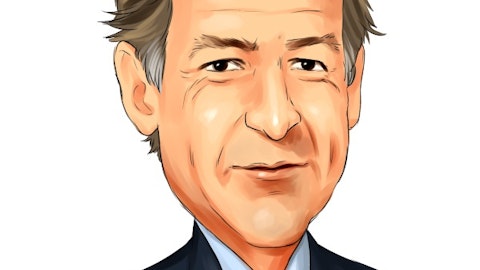Jeremy Goebel: So John, your first question, private versus public, we’re not going to disclose any information from our customers, but generally a lot of the private inventory has been sold into the public hands. So the privates are now buying back from the independents, lesser-loved assets and starting to redevelop again. But I focus on the public, it has been consolidated to look at their growth forecast and that’s largely consistent with our forecast. And as far as the EBITDA refresh, I’m not sure I got that question.
John Mackay – Goldman Sachs: Yeah, I guess last year on the call you said maybe like a 100,000 barrel a day swing for the basin would be like $10 million to $15 million EBITDA impact. Just curious, if that number is still fair for 2024 or there’s some other moving pieces in there to refresh?
Jeremy Goebel: Yes, sir, that’s consistent with the contracting profile we have. So, there’s not a lot of turn in the contract, so it doesn’t really change much.
John Mackay – Goldman Sachs: Okay. And then just to follow-up kind of staying in the same theme, but when you guys did the Oryx buy-in part of the narrative was eventually overtime we should be able to use this bigger footprint to flow more volumes into our long-haul side. Just curious, if you could give us a bit of an update there and maybe if we look at your ratio of kind of gathering to long-haul volumes going forward, maybe how that ratio changes from here or not? Thanks.
Jeremy Goebel: Well, one thing is I wouldn’t consider the Oryx buy-in, right? That’s our partner and we’ve merged those assets together, so I just want to make sure we’re clear on that. But second, the JVs done exactly what we thought we would. And I would say, it is bolted our relationship with our customers across the basin and given us the opportunity to provide integrated economics. But as for the markets will dictate where barrels flow and pricing dictates where they flow. And so, we have strong relationships and the ability to contract our pipes, but they can only be so full. And so barrels have to flow in other directions as well, and we’re completely comfortable with that.
John Mackay – Goldman Sachs: All right. That’s clear. I appreciate the time today. Thank you.
Operator: Thank you. One moment for our next question. Our next question comes from Theresa Chen with Barclays. Your line is now open.
Theresa Chen – Barclays: Good morning. I had a quick follow-up related to Jean’s earlier question on TMX’s impact on your crude marketing business. Completely understanding that the differentials to both Mid-Con and Gulf Coast should be constrained, especially upon linefill, but as TMX delivers barrels to the West Coast backing out some of the Middle East and LatAm imports, and given your liquids infrastructure business there as well as your marketing presence. Is that potentially a source of upside to crude marketing in 2024, relative to opportunities in 2023, as those waterborne imports are backed out and the flows and differentials change in California?
Willie Chiang: Theresa, this is Willie. It is a complex question that’s hard to put a pen to. What I can assure you is that, we have a very flexible system and that wherever flows will go, I think we’ll be able to adapt to that and capture value perhaps in different parts of our system. Long-term, I look at this as very constructive, because with more takeaway capacity to the West Coast, I think it allows a better price signal to producers to be able to produce more short-term. We could see some headwinds, but I can assure you that, we’ll adapt to that. Whatever the markets are, we’re going to try to look and see how we can use our assets to capture value.
Theresa Chen – Barclays: Thank you.
Willie Chiang: Thanks, Theresa.
Operator: Thank you. And one more for our next question. Our next question comes from Timm Schneider with the Schneider Capital Group. Your line is now open.
Timm Schneider – The Schneider Capital Group LLC: Hey, good morning, guys. It’s been a while. How are you?
Willie Chiang: Hi, Timm.
Timm Schneider – The Schneider Capital Group LLC: Thanks for all the color on the Permian. Quick question for me, kind of higher level question on a sector strategic initiative. So we’ve seen a ton of M&A activity on the upstream side, we already saw some of these blockbuster transactions. So I have two questions for you on this. Number one, how do you view upstream M&A, specifically kind of for Plains and for the midstream sector? Is that good for you, bad for you, kind of neutral? And the second follow-up I have to that is, how do you think upstream M&A, this large scale upstream M&A, ultimately trickles sort of midstream sector? Because we haven’t really seen any blockbuster transactions there, right, we’ve seen one big deal over the last, call it, 12 to 18 months that had some, call it, tax attributes to it? Or is it more so smaller bolt-ons and that’s the way to go? So just curious as to what your thoughts are on that.
Willie Chiang: Well, Timm, short answer on the question. For upstream consolidation and the impact on Plains with our asset base and the relationships we have, I don’t think it’s going to be a material impact on us. We work with, if not all, most of the large players. So we’ve got volumes that flow on our systems today, and they’re tied with contracts. And the way I think about it is if you have stronger counterparties in tougher environments, we’re fine if they want to develop the Permian in a more thoughtful and efficient way, because we’re a long-term company and we want to be around for a long time. So whether or not the production comes this year, next year or the following year, the stability is probably a very positive thing for us.





